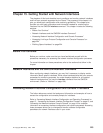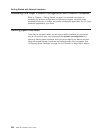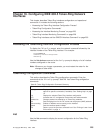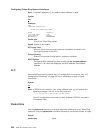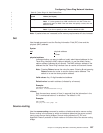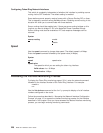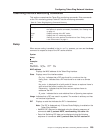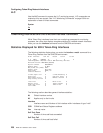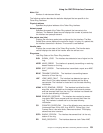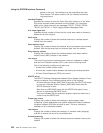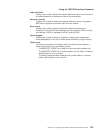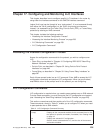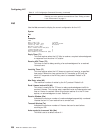
Token-Ring Interface Monitoring Commands
This section summarizes the Token-Ring monitoring commands. Enter commands
at the TKR> monitoring prompt. Table 30 lists the monitoring commands.
Table 30. Token-Ring Monitoring Command Summary
Command Function
? (Help) Displays all the commands available for this command level or lists
the options for specific commands (if available). See “Getting Help”
on page 10.
Dump Displays a dump of the RIF cache.
LLC Displays the LLC monitoring prompt.
Exit Returns you to the previous command level. See “Exiting a Lower
Level Environment” on page 11.
Dump
When source routing is enabled in the tkr config> process, you can use the dump
command to request a dump of the RIF cache contents.
Syntax:
dump
Example:
dump
MAC address State Usage RIF
0000C90B1A57 ON_RING Yes 0220
MAC address
Displays the MAC address of the Token-Ring interface.
State Displays one of the interface states:
On_ring - indicates that a RIF was found for a node on the ring.
Have_route - indicates that a RIF was found for a node on a remote
ring.
No_route - is displayed for a brief period of time as an explorer frame is
sent out and the router is waiting for a return.
Discovering - indicates that the router sent an explorer frame to
rediscover the RIF.
St_route - indicates that a route obtained from a Spanning tree explorer.
Usage Indicates that a RIF was used in a packet. The number is arbitrary and has
no functional significance.
RIF Displays a code that indicates the RIF in hexadecimal.
Note: The RIF is displayed only if Source Route Bridging is enabled on the
Token-Ring interface.
v NetBIOS RIF data can be displayed using the following sequence of
commands: talk 5, protocol ASRT, name-caching, list cache rifs.
v Data Link Switching RIF data can be displayed using the following
sequence of commands: talk 5, protocol dlsw, list llc2 session all.
Configuring Token-Ring Network Interfaces
Chapter 16. Configuring IEEE 802.5 Token-Ring Network Interfaces 229





